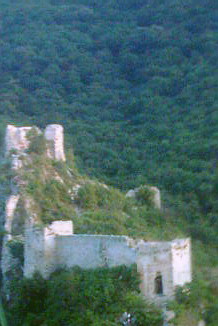Soko Grad (Sokobanja) on:
[Wikipedia]
[Google]
[Amazon]
Soko Grad ( Serbian Cyrillic: Соко Град), also known as Sokolac, is a medieval city and fortress 2 km east of the spa town of Sokobanja, Serbia. The fortress was declared a Monument of Culture of Great Importance in 1982, and it is protected by Republic of Serbia.


Soko Grad article
in Politikin Zabavnik
Section Fortress - Soko Grad
Forts in Serbia Ruins in Serbia Medieval Serbian architecture Cultural Monuments of Great Importance (Serbia) Tsardom of Vidin {{Serbia-struct-stub
History
The fortress was founded in the 6th century during the reign of Eastern Roman Emperor Justinian I, to prevent incursions of Pannonian Avars andSlavs
Slavs are the largest European ethnolinguistic group. They speak the various Slavic languages, belonging to the larger Balto-Slavic branch of the Indo-European languages. Slavs are geographically distributed throughout northern Eurasia, main ...
into Balkan peninsula
The Balkans ( ), also known as the Balkan Peninsula, is a geographical area in southeastern Europe with various geographical and historical definitions. The region takes its name from the Balkan Mountains that stretch throughout the who ...
. In 1172, it was occupied by Stefan Nemanja and became part of the medieval Serbian state
Serbia in the Middle Ages refers to the medieval period in the history of Serbia. The period begins in the 6th century with the Slavic migrations to Southeastern Europe, and lasts until the Ottoman conquest of Serbian lands in the second half ...
. During the expulsion of the Bogomils from Serbia, Nemanja had a clash with the administrator of Soko, who was a Bogomil himself. Ottoman Empire occupied it in the year 1398. The town was destroyed in a violent Ottoman attack, and today the only thing visible is the remains of the upper town with a gate, walls, and three towers. Soko Grad translates as "falcon city". It got its name because there were many falconers in the town, who paid taxes with trained falcons.

Characteristics
The original fortification built by Justinian was the citadel built on the tallest part of the rock, rendering it practically unreachable by the enemy. During the subsequent development in Serbian state, the fortress expanded around the citadel and spread lower down the rock. In the middle of the fortification on the top was a citadel with a dominant main tower. From there bulwarks were lowering toward Moravica, forming that way space of Lower town, that was built on more reachable ground. The entire fortification complex had several towers, of which only a few remain today. Only the first entrance tower in Upper town is preserved and in good shape, while other towers and bulwarks are in ruins.
See also
*Monuments of Culture of Great Importance Immovable Cultural Heritage of Great Importance ( sr, Непокретна културна добра од великог значаја / ''Nepokretna kulturna dobra od velikog značaja'') are those objects of Immovable cultural heritage that enjo ...
* Tourism in Serbia
References
External links
Soko Grad article
in Politikin Zabavnik
Section Fortress - Soko Grad
Forts in Serbia Ruins in Serbia Medieval Serbian architecture Cultural Monuments of Great Importance (Serbia) Tsardom of Vidin {{Serbia-struct-stub